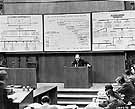
|
|
|

|

|

|

|
|
Click on an image to see a larger, more detailed picture.
|
|
|
|
|
| EPILOGUE: The Aftermath |

|
pg. 692 |

|
|
|
|
| |
 Although Krupp, Germany's largest arms manufacturer, was ordered dissolved following a postwar trial (above), the order was never carried out. Intense public pressure 50 years later prompted Krupp to offer financial restitution to Jewish and other slave laborers it had abused.
Although Krupp, Germany's largest arms manufacturer, was ordered dissolved following a postwar trial (above), the order was never carried out. Intense public pressure 50 years later prompted Krupp to offer financial restitution to Jewish and other slave laborers it had abused.
Photo: National Archives / United States Holocaust Memorial Museum Photo Archive
|
|
One goal of the 1998 Washington Conference was to deal with Nazi-confiscated art treasures. During the past 50 years, much of that art has been sold and resold. Some of it has been purchased and displayed by world-renowned art museums, which may or may not have known the full history of these valuable works. Tracking the history of the artworks, and then returning them to the rightful owners, is a large and complicated task. As much as 20 percent of Europe's major artworks was confiscated by the Nazis. Philip Saunders, a specialist in stolen art, estimated in 1997 that 100,000 pieces of valuable art are "still missing from the Nazi occupation." Reflecting the diverse areas to which Jews fled from Nazism, claimants come from far and wide--Israel, Canada, Australia, and the United States as well as European countries. They range from individuals who are trying to find art that was displayed in their former homes to art collectors who had loaned pieces to museums and galleries that fell prey to Nazi theft. In some cases, documentary evidence overwhelmingly supports the claimants. In other instances, just as Estelle Sapir could produce no Majdanek death certificate for her father when she approached Credit Suisse, the original owners of the confiscated art may know that a piece of art is theirs when they see it, and yet the difficulty of documenting ownership remains. Artworks account for only a part of the household assets stolen by the Nazis. When Soviet forces reached Auschwitz in January 1945, they found six storerooms that contained hundreds of thousands of men's suits and women's coats. Property of this kind--furniture, furs, family heirlooms--may be "too small" to be considered by Holocaust-era assets negotiations 50 years later. But when one considers that the Nazis killed nearly six million Jews, uprooting millions more and turning them into refugees, and that the expropriation of Jewish property was an essential ingredient in Nazi policy, then the amount of lost household assets--small and large--becomes utterly mind-boggling. As the 20th century ended, valiant efforts were made to advance restitution, which is unavoidably destined to be woefully incomplete because the losses are so great and too much time has passed to adequately identify, sift, and sort the myriad claims.
|
|

|

|

|

|
 May 19, 1997: Long-secret documents released by Britain's Public Record Office prove that the mass extermination of Jews began as early as June 1941--several months before the date commonly thought to mark the beginning of the "Final Solution."
May 19, 1997: Long-secret documents released by Britain's Public Record Office prove that the mass extermination of Jews began as early as June 1941--several months before the date commonly thought to mark the beginning of the "Final Solution."
|
 July 1997: Argentina establishes a government commission to determine the number of Nazi war criminals who fled to Argentina following the war, and what kinds of Nazi loot were brought into the country.
July 1997: Argentina establishes a government commission to determine the number of Nazi war criminals who fled to Argentina following the war, and what kinds of Nazi loot were brought into the country.
|
 August 20-23, 1997: In reports published by the Swedish newspaper Dagens Nyheter, journalist Maciej Zaremba asserts that the Swedish government sterilized approximately 60,000 Swedish women during the war years to rid Swedish society of "inferior" racial types, and to foster proliferation of Aryan physical attributes.
August 20-23, 1997: In reports published by the Swedish newspaper Dagens Nyheter, journalist Maciej Zaremba asserts that the Swedish government sterilized approximately 60,000 Swedish women during the war years to rid Swedish society of "inferior" racial types, and to foster proliferation of Aryan physical attributes.
|
 August 24, 1997: The World Jewish Congress rejects Germany's offer of one-time reparations payments to Holocaust survivors living in Eastern Europe. WJC secretary general Israel Singer insists that these survivors be granted monthly pensions.
August 24, 1997: The World Jewish Congress rejects Germany's offer of one-time reparations payments to Holocaust survivors living in Eastern Europe. WJC secretary general Israel Singer insists that these survivors be granted monthly pensions.
|
|
|
|
|
| EPILOGUE: The Aftermath |

|
pg. 692 |

|
|
The Holocaust Chronicle
© 2009 Publications International, Ltd.
|
|
